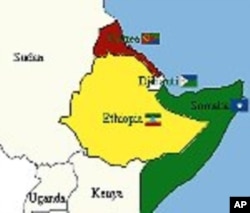The East African Community, a grouping of 5 countries in and around the Horn, is continuing to work towards its goal of regional economic integration. Members of the EAC are dropping barriers to trade, with the goal of eventually adopting a common currency.
The East African Community is rapidly evolving. The region of nearly 130 million people has an overall GDP of about 60 billion dollars, and is still growing.
Over the past 10 years, it has launched a Customs Union with the phased introduction of common tariffs. In essence, all countries have a uniform set of duties on imports coming from outside the region. And it has eliminated duties on goods and products traded among EAC member countries.
It‘s also enacted a common set of regulations called the Common Market Protocol that calls for all countries to adopt common laws on labor, taxation and immigration. The protocol also promises the free movement of services and workers, who are allowed to settle in any of the member countries.
Plans are underway for a $50 million dollar regional railway system to be completed over the next 5 years. Tanzania and Kenya are finalizing plans to interconnect their power systems. They’re also building a 240-kilometer road and trade route that will connect Arusha to Nairobi and to Mombasa.
The original EAC was created in 1967, but dissolved 10 years later.
Martin Shikuku is a veteran Kenyan politician and a proponent of regional integration who witnessed the formation and the eventual collapse of the original grouping:
“It’s not a new idea because we used to have one currency during the colonial days and we used to travel from one country to another. We had no problem with people moving from [country to country]. It is only after independence that this question of immigration [developed]. [But today] we want to have an East African Community that could benefit all the people of East Africa and have a bigger market that could be recognized just like the European Union.”
Various factors are blamed for the break-up of the original union, including the differences between Tanzania, with a socialist economic system, and market-oriented Kenya. Also contributing to the break-up were political differences between rulers, including Idi Amin of Uganda and Julius Nyerere of Tanzania.
Today, says University of Nairobi political scientist Peter Wanyande, it’s clear to regional leaders that there’s more to gain by coming together as a common market:
“Integration, particularly the type we are talking about, is usually supported because member states believe that there are benefits to be derived. These benefits are not uniform. Rwanda and Burundi may benefit because they are landlocked, and therefore feel that if they are in this larger community, it would be easier for their goods to be transported. It’s not very easy to say Kenya will benefit more or Tanzania will benefit more…because there are different elements of benefits to be derived. So each country will join, depending on what benefits they think they will derive from the union.”
Professor Macharia Munene of the Nairobi-based United States International University says with the revival of the East African community over the last decade, businesses in the region are growing. Already, the EAC says over the past 5 years, trade has increased among the 5 partners by nearly 50%.
Among the businesses profiting from an integrated market is the Kenya-based supermarket chain Nukumatt, which is expanding into Uganda and Rwanda. Munene is encouraged by the progress of the integration effort:
“[The telecommunications industry] is doing well; the Nakumatt chains are expanding, both banking and financial sectors, the ongoing construction of infrastructure…and building industry is expanding very fast. The agriculture industry, especially large scale agriculture, is also going to do well. [For example], if a country like Uganda is better at sugar production than Kenya, then it is in the interest of Kenya to find something different that they are good in production, say coffee or tea. This will ensure agriculture expands in a big way.”
Munene says breaking down barriers to business and boosting job growth among the 5 states is likely to reduce parochialism and ethnic tensions.
But moving from an economic union to a political one may be more difficult.
Kenya political scientist, Wanyande, says the larger the EAC becomes, the more difficult it becomes to manage disagreements. And although the grouping also includes a regional court and legislature, problems between them are still decided at a yearly meeting of the so-called Summit, an organ of the EAC made up of the heads of state of the 5 countries that make up the community.
“Tensions will continue to exist, “ says Wanyande. “ For example, it is unfortunate that even with the revival of the community, the Summit still plays a very important role in terms of managing the affairs of the community. So that will still create a problem. You remember recently there was tension between Kenya and Uganda over the Migingo Island. And you can be sure that could actually affect the meetings of the Summit of the EAC.”
On the other hand, political progress continues, although incrementally. In December, leaders of the EAC pledged to join forces to fight climate change.... They’ll work to craft a new policy to ensure that food surpluses in one country can help alleviate shortages in another. They’re also working to strengthen infrastructure that could help with production, storage and transportation of strategic food products from across the region.
Supporters say building a strong EAC is just part of boosting African development. Developing economic and political relations between countries of a region is the first step. The next, they say, is strengthening ties among all of Africa’s regional blocks until the whole continent is interconnected.







